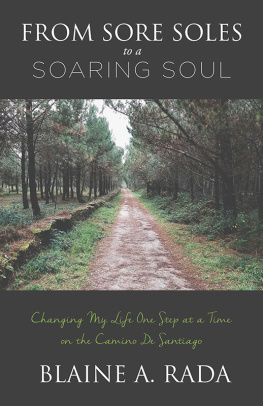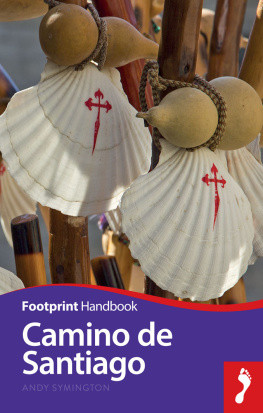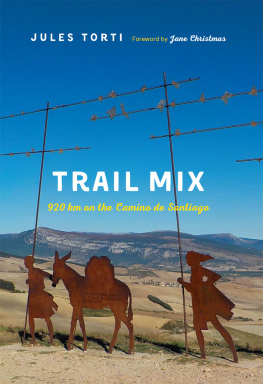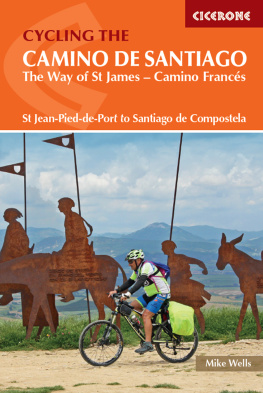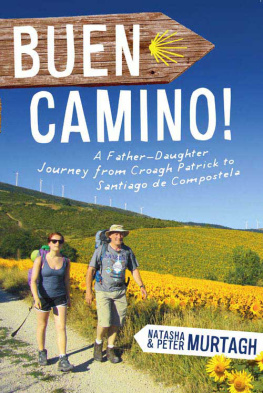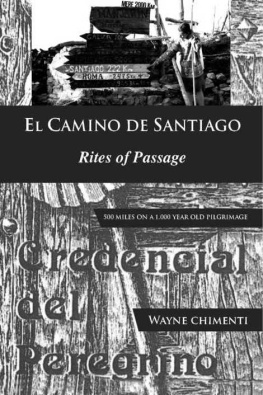A Journey of Days: Relearning Lifes Lessons on the Camino de Santiago
To my wife, Carroll, my life companion,
who is always there for me.
Foreword
Dear Reader,
The pilgrimage to Santiago de Compostela in Spain is a trip of almost 800 kilometres. It has been described as a journey, not only to a physical destination, but to the interior of oneself. Every pilgrim undertakes this journey with his own baggage and objectives--sometimes shared, sometimes kept within.
Join in as Guy Thatcher shares some of his reasons and many of his experiences with us.
I hope that you learn something new about Guy and yourself as he takes you on his journey.
Paul OHagan
Acknowledgements
I want to start by acknowledging two people, Carroll Thatcher, my wife, and Meredith Thatcher, my daughter, whose quiet and insistent persuasion, in spite of my repeated intransigence, convinced me to take with me and keep a journal of the events of my journey, without which there would have been no book, no record at all of the weeks of my adventures in northern Spain. I was strongly--and wrongly--opposed, for a long time, to the very idea of keeping a journal. I thought that it would detract from my experience. I was wrong and I appreciate their persistence in this matter--although I didnt at the time. They also spent many, many hours searching by phone and via the Internet for my lost backpack and forwarding my e-mails to interested friends, and they set up the Weblog from which this book is derived.
Thanks to Ali Black, Marjorie Kort, and to Jim and Sandra Gervais, who shared their previous experience, books, and material on the camino. They gave me an abundance of good and useful advice over dinner and good red wine. To Marilyn Carty, who loaned me one of her treasured books about the camino. To the front desk staff at the Hotel Maissonave in Pamplona, Henrik, Ander, Raquel, Pilar, and Aitor, who tried their best to help solve the missing backpack problem and were helpful in finding replacement items in Pamplona. To Jos Luis Garcia Cuartero in Madrid, who gave up most of a day to help me deal with the lost baggage at the airport, then treated me to lunch at Atocha station while I waited for my evening train back to Pamplona.
To the people I met on the camino, Martin from Constance, Hannelore from Hamburg, Walter and Roswitha from Cologne, Eva and Richard from Augsburg (who gave me his only fleece), Heinz from Munster, Vicente, Miguel and Vicente, the three compadres from Spain, the Aussies from Brisbane who brightened my days near and in Santiago, Sturla Pilskog and Mari Bjrnstad from Oslo, who are preparing a documentary about the camino, and to Adrie from Holland. To the people with whom I walked, Georg from Bremen, Wayne from south of London, Veronica and Julian, the teachers from Normandy, Tina from Germany, Andreas from Germany, Ferran from Barcelona, Eva Papp from Budapest, and especially to three people: Paula from Bremen, Karsten from Berlin, and Marina from Hamburg, with whom I walked for almost three weeks. They gave me a glimpse into another generation and gave me permission to quote their words in this book.
To Kirsti Antila from Finland, who loaned me her cell phone to call Canada on my wedding anniversary, and Suzie from Montreal, who talked with me and brightened my day while I was recuperating from a walking injury and who suggested that I should write a book--this book.
To the hospitaleras and hospitaleros at all the albergues on the camino, many of whom are unpaid volunteers, for their warm welcome, love and care, dry, clean beds, security, food, advice about the camino, and laundry facilities.
To my dear old friend Fern Charbonneau of Quebec City, for his engaging commentary on my blog while I was travelling. To my book club, who asked that they be allowed to use my draft book as one of the books they discuss.
To my family, to my sister-in-law Maryan OHagan for her encouragement and unconditional love over the years, to her son and my nephew Paul OHagan for his interest and encouragement, to my English cousin Dr. Roger Sage, of Whipsnade, for his medical advice early on--drink a lot more water-- and for his offer to come and help when I was briefly laid up, to his wife, Jackie, for her review of an early draft of this book and her excellent advice, to my brother Ance Thatcher of Candia, New Hampshire, for his manuscript review and his comment on scythes, and to Jim Holmes of Ottawa and John McGee of Atlanta for their careful reviews of the draft and their perceptive and helpful criticism.
To my daughter-in-law, TJ Sharp, who produced the wonderful artwork for the cover of this book.
To the Confraternity of Saint James, London, , for more good advice closer to home.
To my publisher, Tim Gordon, for his faith in me; to my editor, Jane Karchmar, for her sensitivity and excellent advice; and to my publicist, Alison Roesler, for her enthusiasm and good ideas, without all of whom this would still be just a dream.
And thanks above all to my wife, Carroll, for her constant love, quiet encouragement, and practical advice, without whom the journey itself would probably not have happened, and without whose abundant tolerance this book would certainly not have been written.
Introduction
This is not your typical vacation. It starts normally enough; an international flight, a connecting flight, a train to an old European city, a nice hotel, a few days of wandering around the city. Then one April morning I step out of the hotel, turn left, and start walking by myself for hundreds of kilometres across country I have never seen before, using only a rudimentary map from a guidebook. How bizarre is that? But that is exactly how it happened. This is the story of that journey.
This book is organized into six sections: the Prologue describing the preparation for the journey, four sections representing each one of the major political regions that I walked through: Navarre, La Rioja, Castilla y Len, and Galicia and an Epilogue.
Prologue
I am going to Spain to walk 800 kilometres of el camino de Santiago, or the road to Santiago, also known as the Way of St. James. I have never been to Spain. I plan to start at St. Jean Pied-de-Port, across Spains northern border with France, just on the northern side of the Pyrenees. The camino is a thousand-year-old pilgrim, and his tomb and shrine has been a major site for Christians. It is not clear to me why I am doing this, except that I feel a compulsion to make this journey. I do not think that I am religious, so this is not a pilgrimage for me, although I hope that the journey will have spiritual overtones. I do not, however, expect that this will be Shirley McLeans camino.
I intended from the start to walk it alone. I would do it either in the spring, mid-April and May, or in the fall, September to mid-October. I figure that I need about five weeks to complete the walk. The choice of dates is based on two major considerations: the weather and the volume of people. For the past thirty-five years, the numbers of people on the camino have been increasing steadily, from a low of six in 1972, to 2,500 in 1986, to 20,000 in 1995, to a high of 100,000 in 2006. Holy Years in Spain see a significant jump in the numbers of pilgrims. In 2004, the most recent Holy Year, the numbers almost doubled to 180,000. The busiest months are July and August, Spains typical months for vacation from work or school.
June, July, and August are also the hottest months in northern Spain, so those three months are definitely out. November, December, January, and February are cold, snowy, and unpredictable. That cuts them out of contention. September and October are pleasant months, but I want to visit New Orleans in late October, and I do not want to have to walk the camino to a tight deadline, so that leaves March, April, and May. In March I will be coming back from a couple of months in Arizona, so, by exclusion, I am walking in April and May. Since I have read and been told that the Pyrenees, where I will be starting, will likely be snow-covered and can have blizzards in March and into April, I plan to start by mid-April and finish by the end of May. That ought to give me the best weather and the least volume of people.
Next page

